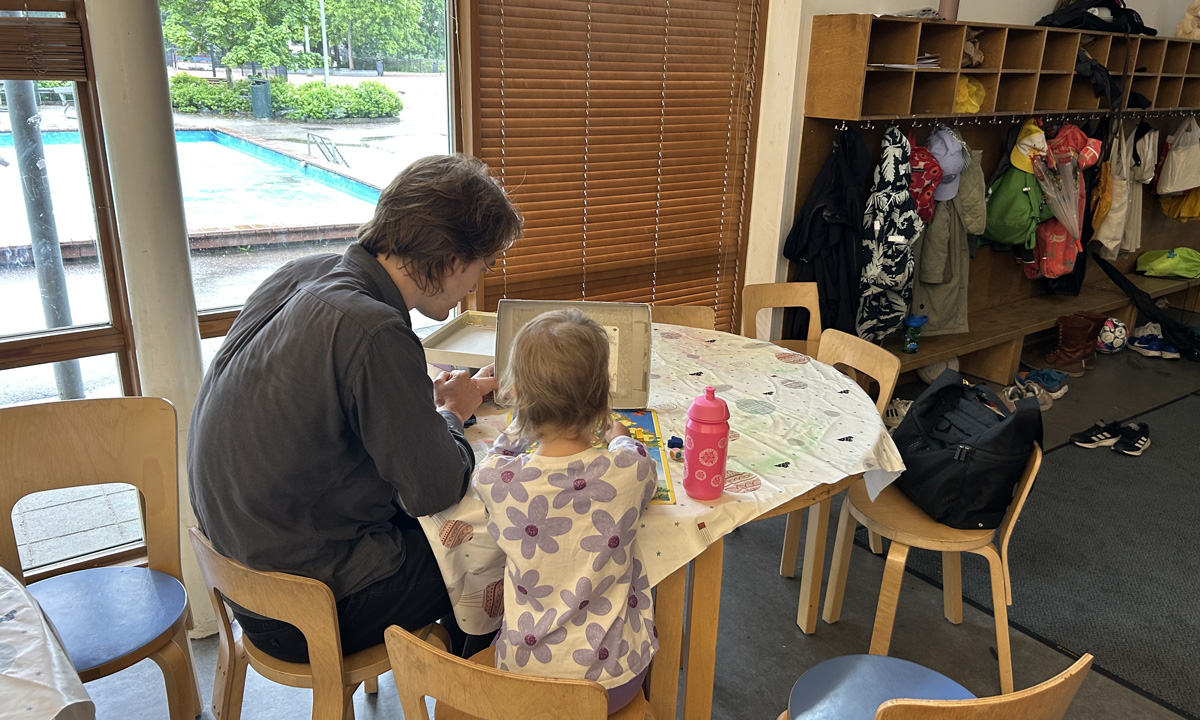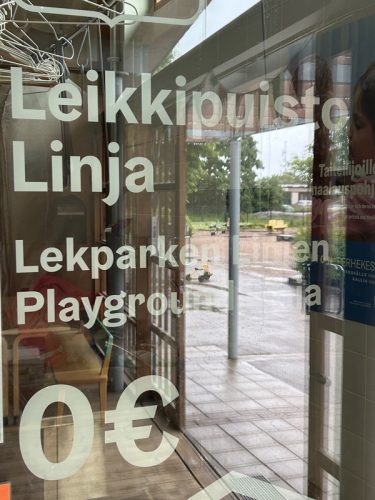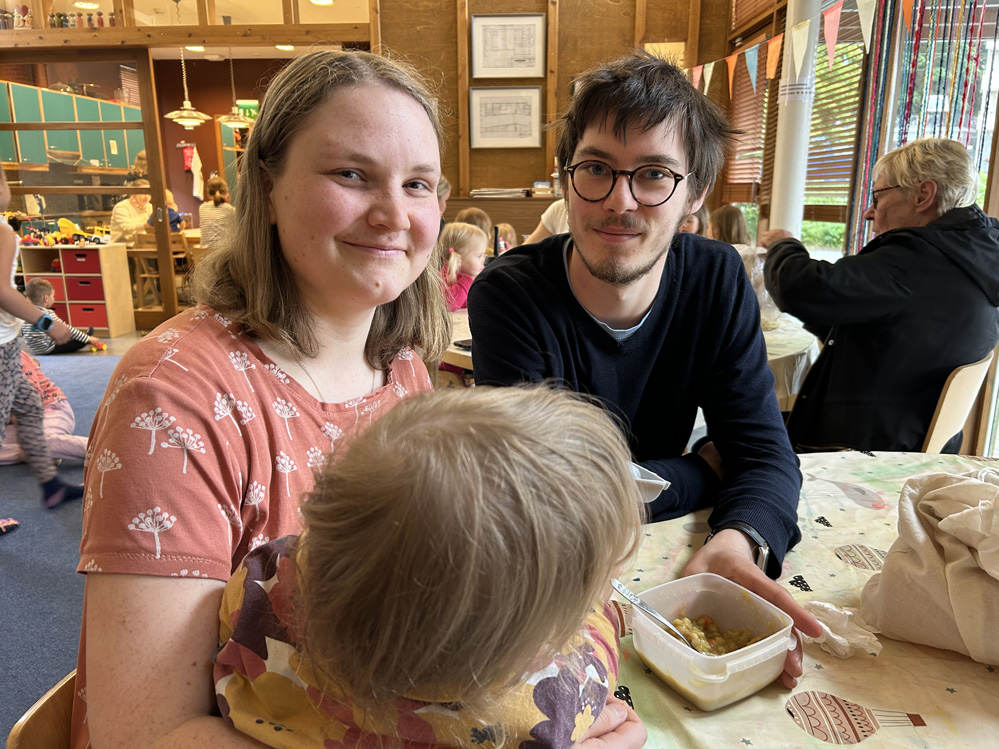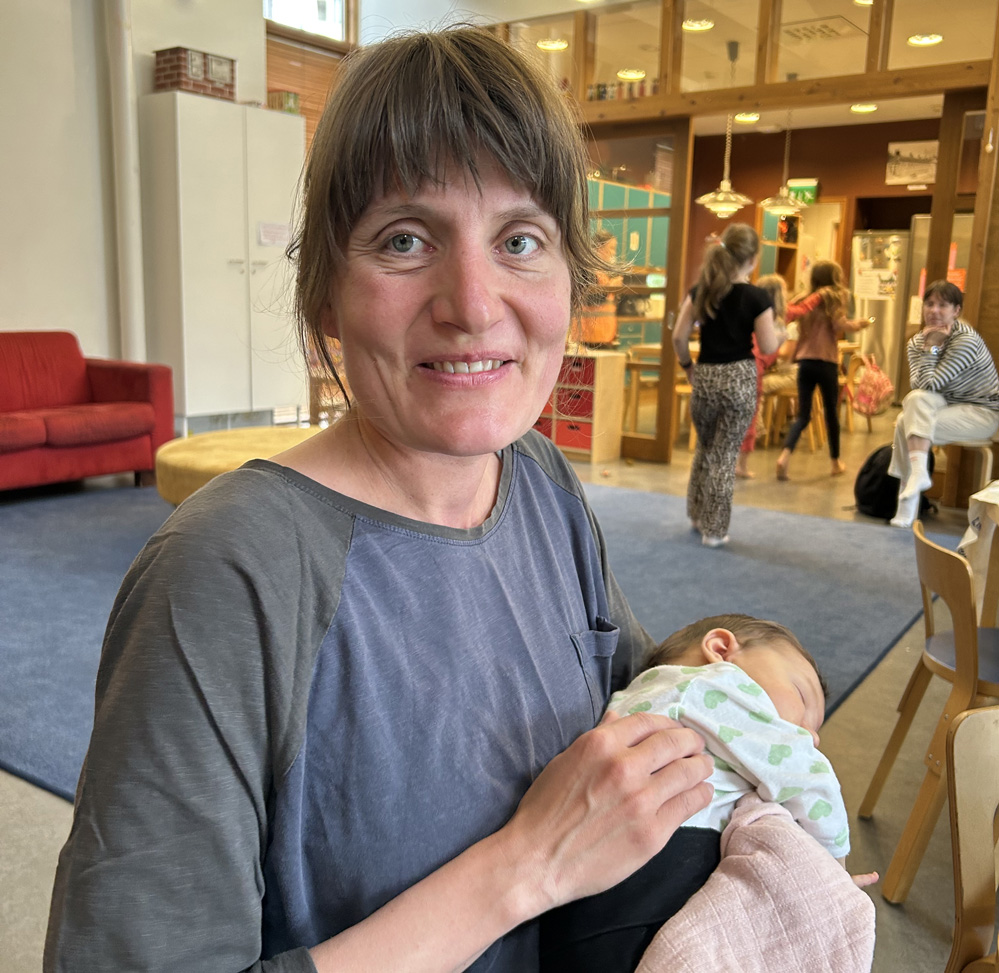Even in a Nation With Robust Family Policies, Stay-at-Home Parents Struggle
Finland and the U.S. take different approaches to family policy, but both limit support for stay-at-home parents.

Join our zero2eight Substack community for more discussion about the latest news in early care and education. Sign up now.
It’s 11 a.m, on a rainy Tuesday and Heidi-Marja Virtanen needs a place to take her toddler. “She gets bored at home,” she said. Their apartment (45 square meters) can feel small if they don’t take her out for part of the day, but in June, much of Finland is on holiday and the child care program Virtanen’s daughter attends is closed for several weeks. She treks over to Leikkipuisto Linja, a free children’s indoor playspace in Helsinki, for a change of scenery.
Undeterred by the rain, a few kids play at an outdoor playground and soccer field, but most are exploring the indoor playroom, which has games, toys, art supplies and a staff that oversees these kids activities. At noon, free lunch will be served to any child who brings their own cup and spoon. Today it’s vegetarian pea soup. The city of Helsinki is footing the bill so kids and families have a reliable place to eat and play.

Finland, like other Nordic countries, boasts generous benefits for families with children: access to free, high-quality prenatal care; an option to take up to three years of paid parental leave; heavily subsidized child care programs, which can be free for families up to a certain income threshold; and spaces like Leikkipuisto Linja that provide play areas and free meals for families. This is in sharp contrast to the United States, which lacks a national child care infrastructure and has no federal paid leave policy. America leaves individual families responsible for arranging maternal health care, navigating parental leave benefits and sorting out child care decisions — and most of child care subsidies and meal programs are means tested and subject to political whims.
The collective-minded Finland and the individualistic United States have taken wildly different approaches to supporting families, but both leave a key population of caregivers struggling: stay-at-home parents. As both nations seek solutions to address a declining birth rate, they may need to consider developing more support for parents who choose to stay home and care for their children.
Limited Benefits for Stay-at-Home Parents
Six months after giving birth, Virtanen went back to work as a lab technician. The decision was purely financial. She wanted to stay at home and care for her daughter, but she was the breadwinner, so her husband, Roope Jokinen took a year off from university, where he studies violin, to be their daughter’s primary caregiver. Shortly after returning to work, Virtanen cut back to part time hours so she could spend a day at home with her daughter each week, but the pay cut has been difficult for their family, especially with Jokinen still in school. Their arrangement allowed the couple to wait until their daughter was 18 months old to enroll her in a child care program, but even then, Virtanen said, it felt too soon. “It might have been easier if she was older,” she said. “She may have understood why we were taking her there.”

In Finland, stay-at-home parent benefits are primarily connected to paid family leave, meaning the time a parent can take from work to care for the birth or adoption of a child. Finland provides paid parental leave via Kela, a government agency that administers benefits under national social security programs. Eligible working parents who decide to care for their own children can apply to receive an income-related parental allowance based on their annual earnings. It has a sliding scale based on income and it decreases significantly after the first year. After a child turns 2 years old, this allowance ends but parents who choose to forgo paid work and care for their child at home can receive a fixed monthly child home care allowance until the child turns 3. And at any point from birth through age 3, a parent can opt for their child to attend a child care program and the cost is generously subsidized by the Finnish government.
But even with the robust ecosystem of family policies in Finland, the economics of caregiving can create stress, especially for parents who want to stay at home to care for their children. For high earners, like Virtanen, the allowance would have been too significant a pay cut, which is why she opted to return to work. And while Jokinen qualified for the minimum allowance because he’s a student, it barely made a dent in the cost of raising a family.
Many American families face similar pressures. While some American workers are eligible to take unpaid family leave through the Family and Medical Leave Act (FMLA), and some states and private employers do offer a paid family leave benefit, many parents find themselves calculating the cost of care against their leave benefits and making decisions they may not view as ideal for child care.
In the U.S., non-working parents who care for their children at home are ineligible for benefits, largely because the handful of child care policies the U.S. has implemented have had an explicit goal of boosting workforce participation. The Lanham Act of 1940, for example, was a federally supported program that subsidized child care for working mothers during World War II. The tax policies designed to offset the costs of child care, such as the Child and Dependent Care Tax Credit, are only available to families in which both parents work. And even states like Vermont and New Mexico, which have generous and innovative child care policies, don’t provide benefits for parents who wish to care for their children.
An Evolving Policy, With Steps Toward Supporting Family Preferences for Child Care
In 2022, Finland took a step toward supporting family preferences. The country expanded its paid leave policy to apply to fathers, allowing them to to take up to six months of paid leave. Before that, the policy only applied to mothers. This change has challenged societal norms around gender and work, explained Miina Pakarinen. Pakarinen is currently on maternity leave with her second son, who won’t get his name until a non-religious naming ceremony in August. He goes by one of his many nicknames, including Paavo, which means pope, since he was born the day Pope Leo the XIV was elected. With her older son, who was born in 2021, Pakarinen spent 10 months at home, and had her mother care for him until he started a child care program at age 1. But with Paavo, Pakarinen is planning to return to work at an employment agency when he turns 6 months old, and then her husband will stay home for six months.

“It’s making our society more equal,” she said of the paid leave split. “Both at home and at work, with who gets to take the time off.” Pakarinen is not interested in being a stay-at-home parent, but acknowledges that creating more choices for families is beneficial, and she’s looking forward to her husband being the caregiver when she returns to work.
This step has helped Finland better support family choice, but the reality remains that even in a country with generous family policies and a strong child care infrastructure, the economics of child care is fraught. Heavily subsidized, high-quality child care may be a solution that works for most families, but there’s not a one-size-fits-all policy for families. And like the handful of child care policies in the U.S., most of the support requires outsourcing the care provided, with little support for families who opt to do it on their own.
Addressing declining birth rates — a challenge Finland and the U.S. share — requires building a more robust, supportive child care system that takes into account family preferences for care. Both countries may need to consider developing family policies, tax credits and incentives that extend to parents who opt to stay home to bond and care for their babies and young children.
For Virtanen, staying at home isn’t in the cards for now. But she said she’d reconsider if she has another child, even if it comes with a financial cost. “I want to be the one caring for her,” she said.
Get stories like these delivered straight to your inbox. Sign up for The 74 Newsletter


;)
